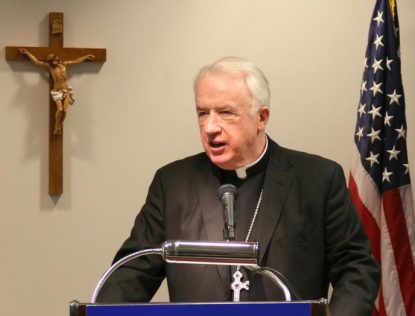
In this 2017 file photo, Bishop Michael J. Bransfield, then head of the Diocese of Wheeling-Charleston, W.Va., is seen at Wheeling Hospital. (CNS photo/Colleen Rowan, The Catholic Spirit)
WASHINGTON (CNS) — A recent newspaper report details claims that senior church leaders in the United States knew as far back as 2012 about complaints against a West Virginia bishop whose spending habits and recent accusations of sexual misconduct have dogged the body of U.S. bishops at a time when they’re seeking a path toward greater accountability for themselves.
A July 3 story in The Washington Post said U.S. and Vatican officials had for years received correspondence from parishioners and others concerned with excessive spending by Bishop Michael J. Bransfield, the former head of the Diocese of Wheeling-Charleston in West Virginia, one of the poorest states in the country.
In total, the newspaper story said, Bishop Bransfield spent more than $4.6 million on the bishop’s residence, $2.4 million on travel and $350,000 on financial gifts to other churchmen, including some who later investigated him.
The local paper, the Charleston Gazette-Mail, had written stories about the complaints of lavish spending, including one published six years ago on July 7, 2013.
[hotblock]
The story was about a group of Catholics who said they had written to Archbishop Carlo Maria Vigano, who was then apostolic nuncio to the U.S., to complain about the bishop’s “extravagant lifestyle,” which included spending the diocese’s money on a chauffeur, a personal chef and other extravagances.
“How can you worry about stained-glass windows and the bishop getting a new high-seated chair when you have poverty like in West Virginia?” parishioner Christine Pennington told the newspaper in 2013.
That same month, Archbishop Vigano flew into West Virginia in a Learjet provided by the West Virginia bishop at a cost of $7,687 charged to the diocese, The Washington Post story said, adding that Archbishop Vigano in an interview told the newspaper that he didn’t recall receiving complaints but it’s possible that they were not given to him.
Last September Pope Francis accepted Bishop Bransfield’s resignation and appointed Baltimore Archbishop William E. Lori apostolic administrator of the statewide diocese with the mandate to investigate the allegations against Bishop Bransfield. The archbishop appointed five laypeople — Catholic and non-Catholic — to carry out the investigation.
In March Archbishop Lori announced a preliminary report by the investigators had been sent to the Vatican; he also announced restrictions on the bishop’s ministry. In June Archbishop Lori announced the group of investigators concluded the claims of excessive and inappropriate spending, along with accusations of sexual misconduct by Bishop Bransfield toward adults, were “credible.”
A full copy of that report by the investigators was obtained by The Washington Post, and Archbishop Lori faced scrutiny of his own. He later apologized in a video for not including in the final report to the Vatican a list of churchmen and others who had received financial gifts from Bishop Bransfield, a list that included his name, as well as the names of three nuncios.
The story in the Post says Pennington, the same parishioner who spoke to the local newspaper in 2012 about the bishop’s spending, wrote to Archbishop Lori that same year to complain about the expenditures. Other parishioners, too, sent letters to other higher-ups, including high-ranking U.S. Cardinal Raymond L. Burke and said their calls for accountability were not heard.
[tower]
But Sean Caine, executive director of communications for the Archdiocese of Baltimore, said in a July 11 telephone interview with Catholic News Service, that when Archbishop Lori initially received some of the complaints about Bishop Bransfield, three letters over the course of seven years, the allegations were made by parishioners who had initially complained about other pastoral issues, such as closing of schools, “with a general comment” about the spending. There was nothing specific, he said, and none of the accusations spoke of sexual improprieties.
A board had approved the expenditures for projects such as the bishop’s residence, Caine said, adding a “metropolitan,” referring to an archbishop with a wider geographical jurisdiction, can coordinate and collaborate with a bishop within the province he oversees, but he has no oversight role and no authority to discipline. It then becomes a matter for the Vatican to handle.
So, when Archbishop Lori received a detailed and firsthand account of possible wrongdoing in 2018, he considered it “serious enough to report that to the Holy See,” Caine said.
The Post’s July 3 report says that it obtained a letter written by Msgr. Kevin Quirk, an aide to Bishop Bransfield, sent to Archbishop Lori in 2018, which is what prompted him to take the matter to the Vatican. It detailed Bishop Bransfield “inappropriately” hugging young priests, “coaxing shirtless photographs of them” and being impaired from night until noon the following day from “the effects of alcohol abuse” as well as Vicodin, according the newspaper story. Bishop Bransfield denied the accusations.
Bishop Bransfield’s resignation was accepted by the Vatican in September 2018; he turned 75 Sept. 8, 2018, the age at which canon law requires bishops to turn in their resignation to the pope, though they are not always asked to immediately to step down.
His resignation, along with the accusations that led to the 2018 resignation of former U.S. Cardinal Theodore McCarrick, who also faced accusations of sexual impropriety, including with minors, were front and center at a June meeting of bishops in Baltimore. Lay Catholics, and some bishops, have increasingly been calling for investigations about which bishops knew about the accusations against McCarrick — and now Bishop Bransfield — and are demanding greater accountability and transparency, even though the Vatican maintains authority over prelates.
PREVIOUS: Connecticut bishops urge ‘complete overhaul’ of U.S. immigration policy
NEXT: As courts mull ACA, Catholic group calls health care ‘basic human right’



Share this story